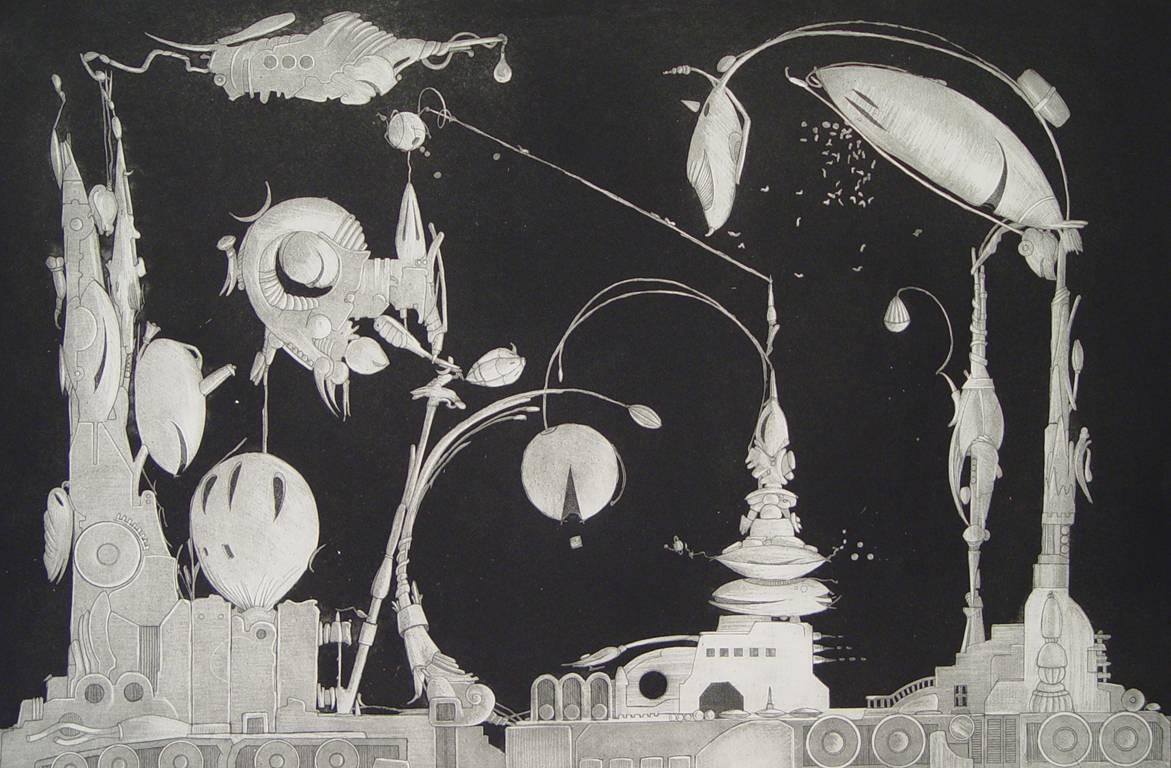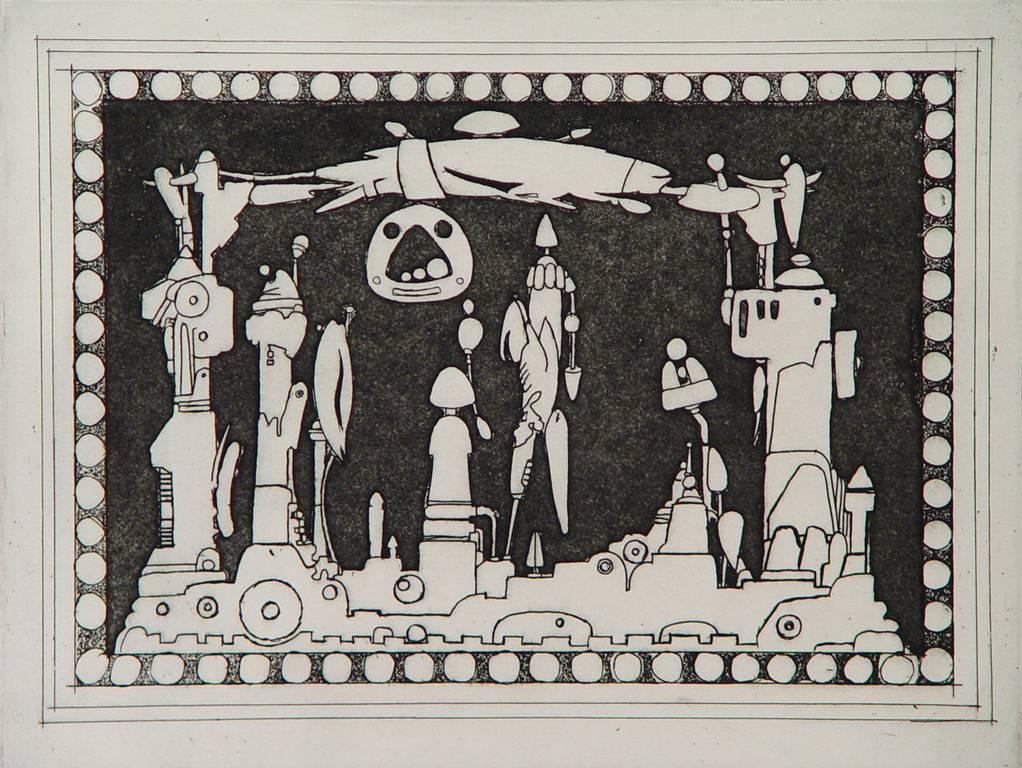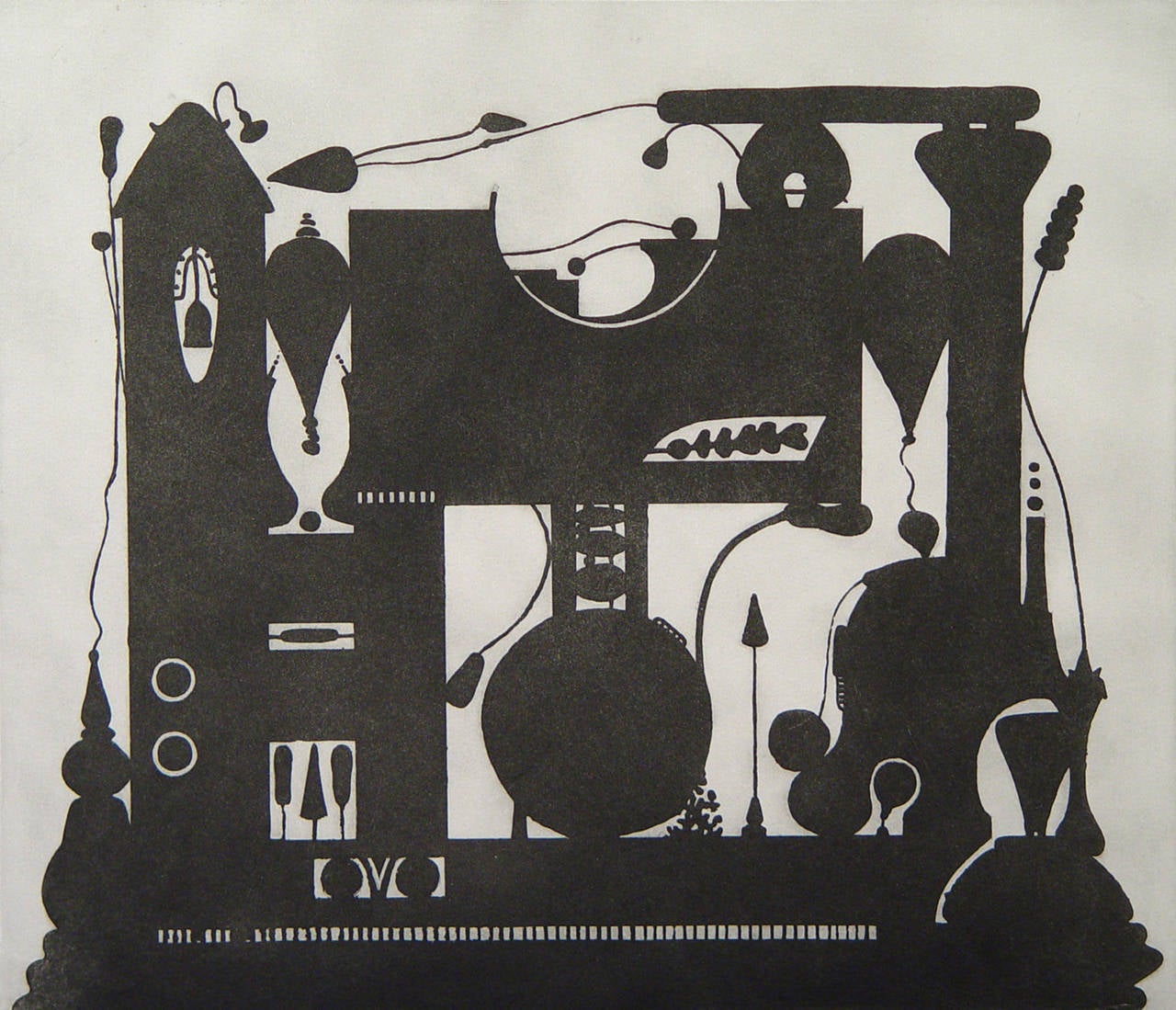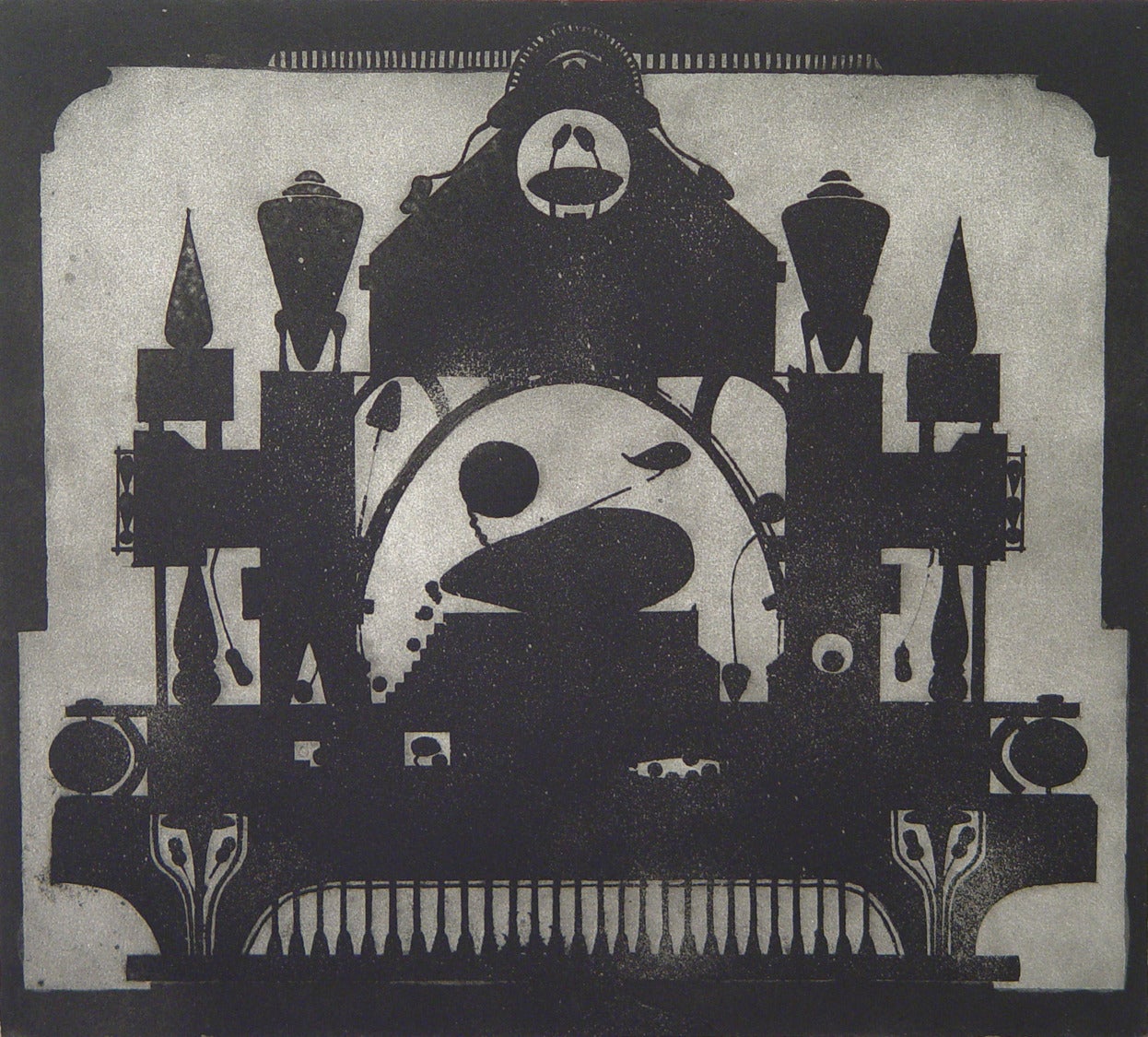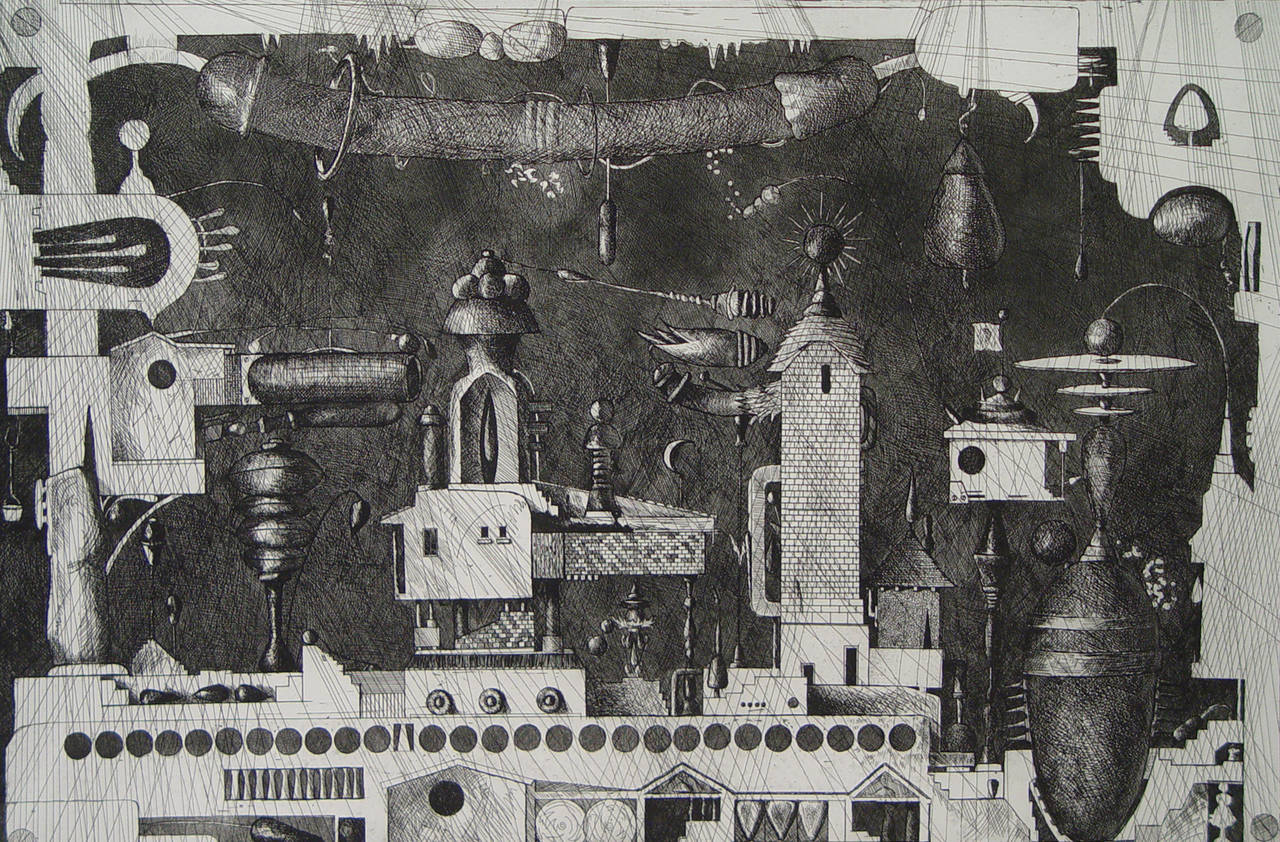Want more images or videos?
Request additional images or videos from the seller
1 of 5
Valton TylerJust Pure Honest Fun1970
1970
About the Item
In The New York Times Arts in America column, Edward M. Gomez writes of Valton Tyler, "visionary seems the right word for describing his vivid, unusual and technically refined paintings, prints and drawings, whose style defies convenient labels. Abstract, surreal, cartoonish, sci-fi fantastic, metaphysical, apocalyptic-Baroque - all of these fit but also fall short of fully describing his art." (The Living Arts, June 13, 2000, p. B2)
Valton Tyler was born in 1944 in Texas, where "the industrial world of oil refineries made a long-lasting impression on Valton as a very young child living in Texas City. He was three years old when the terrible explosion occurred there and can remember the terrifying confusion and 'the beautiful red sky and objects flying everywhere in the air.'" (Reynolds, p. 25) While growing up in Texas City, Valton's father worked in auto repair, and was known for his skill in mixing colors for paint jobs. After leaving Texas City, Valton made his way to Dallas, where he briefly enrolled at the Dallas Art Institute, but found it to be too social and commercial for his taste. After Valton's work was introduced to Donald Vogel (founder of Valley House Gallery), "Vogel arranged for Tyler to use the printmaking facilities in the art department of the Southern Methodist University in Dallas, where the young artist essentially taught himself several demanding printmaking techniques. 'It was remarkable,' Vogel says. 'Not only did he learn complicated etching methods, but he was able to express himself powerfully in whatever medium he explored.' Vogel became the publisher of Tyler's prints. Among them, the artist made editions of some 50 different images whose sometimes stringy abstract forms and more solid, architecturally arresting elements became the precursors of his later, mature style." (Gomez, Raw Vision #35, p. 36)
“Just Pure Honest Fun” is plate number 23, and is illustrated in "The First Fifty Prints: Valton Tyler" with text by Rebecca Reynolds, published for Valley House Gallery by Southern Methodist University Press, Dallas, Texas, 1972.
In “The First Fifty Prints,” Reynolds writes, "Figures the artist usually sets in a roomier and lighter atmosphere are here scaled to fill the borders of the plate. They assume an unfamiliar weight and smoothness when compared to other works concerning the "pedestal portraits." One reason for this new treatment is that Valton worked this design from a detail of a large painting executed in 1968 and from early pen and ink drawings of these same forms. The painting also influenced the artist in his use of heavy outline, smoother surfaces, and large proportions, since these qualities existed in the different medium of oil he was recalling."
Reynolds continues, "After transferring the design onto the plate and using aquatint, Valton sanded the background to achieve greater contrasts between figures and background. Still unsatisfied with the three-dimensionality attained, he reworked the line and added more detail to the surfaces, then burnished desired areas to enhance the contours and surface reflections." (Reynolds, p. 82)
Aquatint and line etching on BFK Rives rag paper
Paper size: 24 1/4 x 17 inches
Edition: 5 Artists Proofs Imp. 50 Signed Prints Imp.
Bibliography:
Edward M. Gomez, "Futuristic Forms Frolic Under Eerie Texan Skies," The New York Times, June 13, 2000, page B2.
Edward M. Gomez, "Valton Tyler's Techno-Organic Landscapes," Raw Vision 35, Summer 2001, pages 34-39.
Rebecca Reynolds, "The First Fifty Prints: Valton Tyler," published for Valley House Gallery by Southern Methodist University Press, Dallas, Texas, 1972.
- Creator:Valton Tyler (1944, American)
- Creation Year:1970
- Dimensions:Height: 17.75 in (45.09 cm)Width: 11 in (27.94 cm)
- Medium:
- Movement & Style:
- Period:
- Condition:
- Gallery Location:Dallas, TX
- Reference Number:
About the Seller
5.0
Recognized Seller
These prestigious sellers are industry leaders and represent the highest echelon for item quality and design.
Established in 1954
1stDibs seller since 2013
151 sales on 1stDibs
Typical response time: Several days
Associations
Art Dealers Association of America
- ShippingRetrieving quote...Ships From: Dallas, TX
- Return PolicyA return for this item may be initiated within 2 days of delivery.
More From This SellerView All
- Front Elevation of Section 17By Valton TylerLocated in Dallas, TXIn The New York Times Arts in America column, Edward M. Gomez writes of Valton Tyler, "visionary seems the right word for describing his vivid, unusual and technically refined paintings, prints and drawings, whose style defies convenient labels. Abstract, surreal, cartoonish, sci-fi fantastic, metaphysical, apocalyptic-Baroque - all of these fit but also fall short of fully describing his art." (The Living Arts, June 13, 2000, p. B2) Valton Tyler was born in 1944 in Texas, where "the industrial world of oil refineries made a long-lasting impression on Valton as a very young child living in Texas City." (Reynolds, p. 25) After leaving Texas City, Valton made his way to Dallas, where he briefly enrolled at the Dallas Art Institute, but found it to be too social and commercial for his taste. After Valton's work was introduced to Donald Vogel (founder of Valley House Gallery), "Vogel arranged for Tyler to use the printmaking facilities in the art department of the Southern Methodist University in Dallas, where the young artist essentially taught himself several demanding printmaking techniques. 'It was remarkable,' Vogel says. 'Not only did he learn complicated etching methods, but he was able to express himself powerfully in whatever medium he explored.' Vogel became the publisher of Tyler's prints. Among them, the artist made editions of some 50 different images whose sometimes stringy abstract forms and more solid, architecturally arresting elements became the precursors of his later, mature style." (Gomez, Raw Vision #35, p. 36) "Front Elevation of Section 17" is plate number 34, and is reproduced in "The First Fifty Prints: Valton Tyler" with text by Rebecca Reynolds, published for Valley House Gallery by Southern Methodist University Press, Dallas, Texas, 1972. In "The First Fifty Prints," Reynolds writes, “this plate can be seen as a culmination of the artist’s earlier uses of aquatint and as a new direction the artist will take in his compositions. In early plates such as ‘Joy,’ Plate No. 12, and ‘Do Not Touch,’ Plate No. 20, the artist has presented his designs to our unaccustomed eyes, either formally, by placing them on sculpture pedestals, or more abstractly, using smaller soft ground silhouettes. In later examples such as ‘One Little Stage,’ Plate No. 24, or ‘Heritage,’ Plate No. 25, we were brought closer to a direct interaction with the forms as they began to fill the plates with increasing sculptural and monumental qualities. It was still possible to maintain a more passive point of view because of the stage format of the compositions. In ‘Avenue 11,’ Plate No. 26, as we have seen, the artist unveils the true authority of his designs by placing them in our environment to compete with our reality of a familiar cityscape and to make us question our ideas of aesthetics and logic. In ‘Front Elevation’ we enter into and are confronted with these structures in their own massive landscape...Category
1970s Surrealist Prints and Multiples
MaterialsEtching, Rag Paper, Aquatint
- A Sculpture Framed by a PrintBy Valton TylerLocated in Dallas, TXIn The New York Times Arts in America column, Edward M. Gomez writes of Valton Tyler, "visionary seems the right word for describing his vivid, unusual and technically refined painti...Category
Late 20th Century Surrealist Prints and Multiples
MaterialsRag Paper, Etching, Aquatint
- Music BoxBy Valton TylerLocated in Dallas, TXIn The New York Times Arts in America column, Edward M. Gomez wrote of Valton Tyler, "visionary seems the right word for describing his vivid, unusual and technically refined paintin...Category
1970s Surrealist Still-life Prints
MaterialsRag Paper, Etching, Aquatint
- Pillow MachineBy Valton TylerLocated in Dallas, TXIn The New York Times Arts in America column, Edward M. Gomez wrote of Valton Tyler, "visionary seems the right word for describing his vivid, unusual and technically refined paintin...Category
1960s Surrealist Abstract Prints
MaterialsRag Paper, Etching, Aquatint
- Night ShiftBy Valton TylerLocated in Dallas, TXIn The New York Times Arts in America column, Edward M. Gomez wrote of Valton Tyler, "visionary seems the right word for describing his vivid, unusual and technically refined paintin...Category
1970s Surrealist Still-life Prints
MaterialsRag Paper, Etching, Aquatint
- 154 Foot Sculpture That Never WasBy Valton TylerLocated in Dallas, TXIn The New York Times Arts in America column, Edward M. Gomez writes of Valton Tyler, "visionary seems the right word for describing his vivid, unusual and technically refined painti...Category
1970s Surrealist Prints and Multiples
MaterialsAquatint, Rag Paper, Etching
You May Also Like
- Ernst Fuchs Sphinx Mystagoga Surreal Color Etching Vienna Fantastic Realism 1967By Ernst FuchsLocated in Meinisberg, CHErnst Fuchs (Austrian, 1930 - 2015) The Sphinx Mystagogo Sheet Nr. 6 from the Folio “Die Sieben Bilder und Sprüche der Sphinx”, published in Autumn of 1967 by Galerie Sydow in Frankfurt, Germany. • Aquatint Etching • Ed. 79/99 • Sheet ca. 59 x 41.5 cm • Plate signed • Signed & numbered by the artist in pencil Worldwide shipping is complimentary - There are no additional charges for handling & delivery. Ernst Fuchs was an Austrian painter, draftsman, printmaker, sculptor, architect, stage designer, composer, poet, and one of the founders of the Vienna School of Fantastic Realism. I discovered him through H.R. Giger ‘s work, who himself was greatly inspired by the creations of Fuchs and on several occasions exhibited his friend ‘s art in his museum, the Château St-Germain, Gruyères, Switzerland. I actually own the original folio box...Category
1960s Surrealist Abstract Prints
MaterialsPaper, Ink, Aquatint, Etching
- "Untitled"By Nahum TschacbasovLocated in Southampton, NYOriginal engraving, aquatint, intaglio on archival paper. Signed and dated lower right, 1947. Artist proof. Condition: Good. Provenance: Estate of the artist. Image size 6.75 by 5...Category
1940s Surrealist Figurative Prints
MaterialsArchival Paper, Engraving, Aquatint, Intaglio
- "Untitled"By Nahum TschacbasovLocated in Southampton, NYOriginal artist proof engraving, aquatint, intaglio on archival paper by the Russian/American artist, Nahum Tschacbasov. Signed in pencil lower right and dated 1947. Condition: good...Category
1940s Surrealist Figurative Prints
MaterialsArchival Paper, Engraving, Aquatint, Intaglio
- Spanish Artist hand signed limited edition original art print drypoint n7By Salvador DalíLocated in Miami, FLSalvador Dali (Spain, 1904-1989) 'La Cour du Lion', 1974 Serie: Le Bestiaire de La Fontaine dry point, aquatint on japanese paper 30.6 x 22.7 in. (77.5 x 57.5 cm.) Edition of 250 Unframed ID: DAL2001-007 Hand-signed by author It appears reviewed in the catalog raisonné: The official catalog of the graphic works of Salvador Dalí. Albert Field. Page: 2/93. Nr. 74-1 J. ______________________________________________________ Salvador Felipe Jacinto Dalí i Domènech was a Spanish painter, sculptor, engraver, set designer and writer of the 20th century. An artist associated with surrealism, he is one of the most important figures in 20th century art, representing the archetype of the spectacular contemporary multifaceted artist. He develops his creative activity in various fields through the most diverse cultural formulas: painting, written media, performing arts, cinema, or public appearances in the press, radio, cinema, advertising, television, etc. Master of the most refined pictorial technique, especially drawing, along with various aesthetic languages - from impressionism, cubism, purism or late ultraism with Dadaist edges to the most radical surrealism, hyperrealism, pop-art or art optical—, will absorb every influence that is useful to build its own and personal language, halfway between technical tradition and thematic avant-garde. His paranoid-critical method is his main contribution to the surrealist movement and to the history of art as a new creative model with which Dalí's theories acquire theoretical entity - thanks to the successive interpretations that the Empordà artist made of his readings of Dalí's work. Sigmund Freud—and practice, applying it as a revealing liquid of images that can be represented plastically through multiple images, anamorphisms, relational mirages, irrational and heterogeneous symbolic images, pseudohallucinations, childhood memories, atavisms, obsessive ideas, etc., and recreating a polyphonic method capable of critically relating any visual or sensitive experience. With his method, Dalí makes paranoid delirium a whole mode of expression of an art that introduces us to the concrete irrationality that inhabits every creative process, constructing not only his works, but also his own character. as an artist. In Dalí, the relationship between his work and his personal history becomes evident. Much of the most significant biographical facts for the artist are implicitly or explicitly present in the content of his work and are the explanation of his complex and contradictory personality. In 1910, at the age of 6, he was enrolled by his father in the Hispano-French school of the Immaculate Conception of Figueres, where he learned French, his future language of culture. Dalí's first contact with Impressionism occurred in 1916, when he spent some time on the outskirts of Figueres, specifically at the Molí de la Torre estate, property of the Pichot family (intellectuals and artists), where he was the collection of the painter Ramón Pichot. In 1919 he participated for the first time in a group exhibition in the halls of the Societat de Concerts, and with a group of friends from the institute founded the magazine Studium, in which he published his first writings. A year later he moved to Madrid to study at the School of Fine Arts. In 1922 he won his first prize at the Concurs-exposició d'obres d'art originals d'students, held at the Galeries Dalmau (Barcelona). This same year he attended the School of Painting, Sculpture and Engraving in Madrid (Royal Academy of Fine Arts of San Fernando), and lived in the Student Residence, where he became friends with prominent personalities such as Luis Buñuel, Federico García Lorca, Pedro Garfias , Eugenio Montes, or Pepín Bello. However, a year later he was expelled from the Academy for his rebellious and revolutionary character, accused of leading a protest. It would be in 1927 when his surrealist period began, after having traveled to the Netherlands and France, meeting Flemish painters and Picasso. In Paris itself, in 1929, through Joan Miró, he came into contact with a group of surrealists headed...Category
1970s Surrealist Prints and Multiples
MaterialsDrypoint, Paper, Aquatint
- Spanish Artist hand signed limited edition original art print drypoint n6By Salvador DalíLocated in Miami, FLSalvador Dali (Spain, 1904-1989) 'L’Elephant et le singe de Jupiter', 1974 Serie: Le Bestiaire de La Fontaine dry point, aquatint on japanese paper 22.9 x 30.8 in. (58 x 78 cm.) Edition of 250 Unframed ID: DAL2001-006 Hand-signed by author It appears reviewed in the catalog raisonné: The official catalog of the graphic works of Salvador Dalí. Albert Field. Page: 2/93. Nr. 74-1 B. ______________________________________________________ Salvador Felipe Jacinto Dalí i Domènech was a Spanish painter, sculptor, engraver, set designer and writer of the 20th century. An artist associated with surrealism, he is one of the most important figures in 20th century art, representing the archetype of the spectacular contemporary multifaceted artist. He develops his creative activity in various fields through the most diverse cultural formulas: painting, written media, performing arts, cinema, or public appearances in the press, radio, cinema, advertising, television, etc. Master of the most refined pictorial technique, especially drawing, along with various aesthetic languages - from impressionism, cubism, purism or late ultraism with Dadaist edges to the most radical surrealism, hyperrealism, pop-art or art optical—, will absorb every influence that is useful to build its own and personal language, halfway between technical tradition and thematic avant-garde. His paranoid-critical method is his main contribution to the surrealist movement and to the history of art as a new creative model with which Dalí's theories acquire theoretical entity - thanks to the successive interpretations that the Empordà artist made of his readings of Dalí's work. Sigmund Freud—and practice, applying it as a revealing liquid of images that can be represented plastically through multiple images, anamorphisms, relational mirages, irrational and heterogeneous symbolic images, pseudohallucinations, childhood memories, atavisms, obsessive ideas, etc., and recreating a polyphonic method capable of critically relating any visual or sensitive experience. With his method, Dalí makes paranoid delirium a whole mode of expression of an art that introduces us to the concrete irrationality that inhabits every creative process, constructing not only his works, but also his own character. as an artist. In Dalí, the relationship between his work and his personal history becomes evident. Much of the most significant biographical facts for the artist are implicitly or explicitly present in the content of his work and are the explanation of his complex and contradictory personality. In 1910, at the age of 6, he was enrolled by his father in the Hispano-French school of the Immaculate Conception of Figueres, where he learned French, his future language of culture. Dalí's first contact with Impressionism occurred in 1916, when he spent some time on the outskirts of Figueres, specifically at the Molí de la Torre estate, property of the Pichot family (intellectuals and artists), where he was the collection of the painter Ramón Pichot. In 1919 he participated for the first time in a group exhibition in the halls of the Societat de Concerts, and with a group of friends from the institute founded the magazine Studium, in which he published his first writings. A year later he moved to Madrid to study at the School of Fine Arts. In 1922 he won his first prize at the Concurs-exposició d'obres d'art originals d'students, held at the Galeries Dalmau (Barcelona). This same year he attended the School of Painting, Sculpture and Engraving in Madrid (Royal Academy of Fine Arts of San Fernando), and lived in the Student Residence, where he became friends with prominent personalities such as Luis Buñuel, Federico García Lorca, Pedro Garfias , Eugenio Montes, or Pepín Bello. However, a year later he was expelled from the Academy for his rebellious and revolutionary character, accused of leading a protest. It would be in 1927 when his surrealist period began, after having traveled to the Netherlands and France, meeting Flemish painters and Picasso. In Paris itself, in 1929, through Joan Miró, he came into contact with a group of surrealists headed...Category
1970s Surrealist Prints and Multiples
MaterialsDrypoint, Aquatint, Paper
- Spanish Artist hand signed limited edition original art print drypoint n14By Salvador DalíLocated in Miami, FLSalvador Dali (Spain, 1904-1989) 'Les Animaux Malades de la Peste', 1974 Serie: Le Bestiaire de La Fontaine dry point, aquatint on japanese paper 22.9 x 30.4 in. (58 x 77 cm.) Editio...Category
1970s Surrealist Prints and Multiples
MaterialsDrypoint, Paper, Aquatint
Recently Viewed
View AllMore Ways To Browse
Vintage Pure
Industrial Design Print
Vintage Reynolds
Oil Paintings Signed Reynolds
Industrial Etchings
Futuristic Retro Art
Vintage Summer Fun
Fun Design Plates
Industrial Explosion Proof
Set Of 4 Architectural Prints
Retro Auto Art
Vintage Auto Prints
Reynolds Etching
Vintage Technical Pen
Sci Fi Oil Painting
Old Vintage Lighter
Old Vintage Lighters
Old Lighters Vintage Lighters
